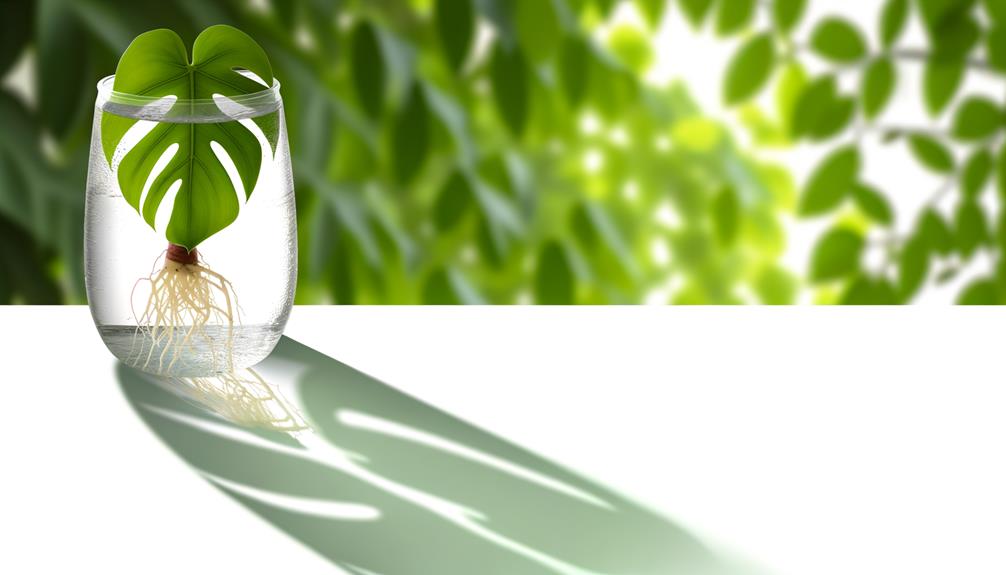How Do I Care for a Monstera Deliciosa Thai Constellation Cutting?
To care for a Monstera Deliciosa Thai Constellation cutting, start by selecting a healthy stem with at least one node and an aerial root. Use sterile tools to cut.
Root the cutting in water, ensuring the node submerges without submerging the leaves. Apply rooting hormone if available.
Once roots reach 2-3 inches, transplant to a well-draining soil mix of peat moss, perlite, and orchid bark. Maintain bright, indirect light and water every 5-7 days or when the top 2 inches of soil are dry.
Want to master the finer points of care? Continue on.

Key Takeaways
- Choose a healthy stem with at least one node and aerial root, free from pests and diseases.
- Root the cutting in water, ensuring nodes are submerged and leaves stay above water.
- Transplant into a well-draining potting mix of peat moss, perlite, and orchid bark.
- Provide bright, indirect light to avoid photodamage and promote healthy growth.
- Water every 5-7 days when the top 2 inches of soil are dry, ensuring proper drainage.
Selecting a Healthy Cutting
When choosing a healthy cutting for your Monstera Deliciosa Thai Constellation, always make certain that the parent plant demonstrates vigorous growth and is free from pests and diseases. Choose a stem that has at least one node and a healthy aerial root. Nodes are crucial as they contain meristematic cells, crucial for new growth.
Inspect the selected stem for any signs of discoloration or lesions, which could indicate underlying issues. A cutting from a robust parent plant guarantees higher success rates in propagation. Additionally, verify the stem is firm and not mushy, as this could be a sign of rot.
Preparing Your Cutting
Begin by selecting a healthy stem with at least one node and aerial root, as these are critical for successful propagation.
Use sterile tools, such as a disinfected pruning shear or a sharp knife, to prevent the introduction of pathogens. Proper preparation greatly enhances the cutting's viability and reduces the risk of infection.
Select Healthy Stem
To ensure successful propagation, choose a healthy stem with at least one node and one or two leaves, showing no signs of disease or pest infestation.
Nodes are crucial as they contain meristematic tissue necessary for root development. Examine the stem's turgidity; it should be firm, indicating optimal cellular hydration. Avoid stems with yellowing or wilting leaves, which may indicate underlying health issues.
Ensure leaves are vibrant and free from chlorosis or necrosis. Inspect for pests such as aphids or spider mites; their presence can hinder growth. Utilize a magnifying glass if necessary to detect small infestations.
Selecting a robust stem enhances the likelihood of rooting, leading to a thriving Monstera Deliciosa Thai Constellation.
Use Sterile Tools
After selecting a healthy stem, ensure your cutting tools are sterile to prevent contamination and promote ideal rooting conditions. Sterilization reduces the risk of pathogenic infection, ensuring excellent growth. Follow these steps to sterilize your tools:
- Clean Debris: First, remove any visible debris from your tools using a brush or cloth.
- Disinfect: Submerge your tools in a 70% isopropyl alcohol solution for at least 30 seconds to eliminate bacteria and fungi.
- Dry: Allow the tools to air dry completely to avoid diluting the plant's natural sap.
- Inspect: Check for any remaining contaminants or rust, as these can harbor pathogens.
Using sterile tools significantly enhances the success rate of your Monstera Deliciosa Thai Constellation cutting.
Rooting in Water
To root your Monstera Deliciosa Thai Constellation cutting in water, select a transparent container to facilitate easy monitoring of root development. Guarantee the container accommodates the cutting without submerging the leaves, maintaining water levels to cover just the nodes.
Regularly inspect for root growth, aiming for roots to reach approximately 2-3 inches before transplanting.
Choosing the Right Container
Selecting the appropriate container for rooting your Monstera Deliciosa Thai Constellation cutting in water involves choosing a vessel that offers ample space for root growth and ensures proper oxygenation. Transparent containers are preferred as they allow you to observe root development. Confirm that the container's diameter is at least 3-4 inches to accommodate root expansion.
Follow these guidelines:
- Material: Opt for glass or clear plastic containers to monitor root progress.
- Size: A minimum depth of 6 inches prevents roots from becoming cramped.
- Shape: Choose a wide-mouthed jar to facilitate easy oxygen exchange.
- Water Level: Maintain water levels to cover the nodes while allowing some aerial exposure.
Appropriate container selection enhances root health and speeds up the propagation process.
Monitoring Root Growth
Regularly assessing your Monstera Deliciosa Thai Constellation cutting's root growth guarantees timely identification of any issues and best propagation success.
Start by inspecting the water daily for clarity and quality; change it if it appears cloudy or foul-smelling to prevent bacterial or fungal proliferation. Utilize a transparent container to visually monitor root development without disturbing the cutting.
Look for white, healthy roots extending from the node, which indicates successful rooting. If you observe dark, mushy roots, that's a sign of rot, and you should trim the affected areas immediately.
Guarantee water temperature remains between 65-75°F (18-24°C) to optimize root growth rates. Maintaining these conditions will enhance the cutting's shift to soil and overall plant health.
Using Rooting Hormone
Applying rooting hormone can greatly enhance the chances of successful root development in your Monstera Deliciosa Thai Constellation cutting. This hormone, often containing auxins like indole-3-butyric acid (IBA), stimulates root cell differentiation and elongation.
Here's how to use it effectively:
- Preparation: Trim the cutting just below a node, ensuring it's about 6 inches long.
- Application: Dip the cut end into the rooting hormone powder, ensuring a thin, even coat.
- Initial Hydration: Place the treated cutting in water for 24 hours to initiate root formation.
- Environmental Control: Maintain high humidity and indirect light to optimize root growth.
Potting in Soil
Once the Monstera Deliciosa Thai Constellation cutting has developed initial roots, transplant it into a well-draining potting mix rich in organic matter to facilitate vigorous growth.
Use a soil blend comprising one-third peat moss, one-third perlite, and one-third orchid bark. This mixture ensures ideal aeration and moisture retention while preventing root rot.
Incorporate a balanced, slow-release fertilizer containing nitrogen (N), phosphorus (P), and potassium (K) in a 3:1:2 ratio to support nutrient uptake. Maintain soil pH between 5.5 and 7.0 for optimal nutrient availability.
Position the cutting in the soil so that the roots are entirely buried, but avoid burying the stem too deeply to prevent stem rot. Water the soil thoroughly, allowing excess water to drain.
Choosing the Right Pot
Selecting the appropriate pot is essential for guaranteeing the healthy growth and stability of your Monstera Deliciosa Thai Constellation. When choosing a pot, consider the following factors:
- Drainage: Guarantee the pot has multiple drainage holes to prevent waterlogged soil, which can lead to root rot.
- Size: Opt for a pot that's 2-4 inches larger in diameter than the root ball to allow for root expansion and aeration.
- Material: Use terracotta or ceramic pots for better moisture regulation; these materials are porous and enhance soil aeration.
- Depth: A minimum depth of 8-10 inches is recommended to accommodate the plant's extensive root system.
Ideal Soil Mix
For best growth of your Monstera Deliciosa Thai Constellation cutting, you'll need a soil mix with specific components. Guarantee the soil has a balanced composition of organic matter, perlite, and bark to enhance drainage and aeration.
Additionally, the substrate must provide essential nutrients like nitrogen, phosphorus, and potassium for healthy development.
Soil Composition Essentials
To provide ideal growth conditions for your Monstera Deliciosa Thai Constellation cutting, a well-draining soil mix comprising equal parts of peat moss, perlite, and orchid bark is necessary. This combination guarantees optimal moisture retention, aeration, and nutrient availability.
Here's why each component is crucial:
- Peat Moss: Retains moisture while maintaining a slightly acidic pH, ideal for Monstera.
- Perlite: Enhances drainage and prevents soil compaction, essential for root oxygenation.
- Orchid Bark: Increases air pockets within the soil, fostering root health and growth.
- Balanced Mix: A 1:1:1 ratio guarantees that each element contributes effectively, ensuring a stable growing environment.
Drainage and Aeration
Maintaining proper drainage and aeration in your soil mix is crucial for preventing root rot and promoting healthy growth in your Monstera Deliciosa Thai Constellation cutting.
Use a well-draining soil mix composed of 40% pine bark, 30% perlite, and 30% peat moss. Pine bark enhances aeration, while perlite improves drainage by preventing compaction. Peat moss retains moisture without waterlogging the roots.
Aim for a pH range of 5.5 to 6.5 to optimize nutrient uptake. Avoid heavy, clay-based soils as they retain excess water and restrict air flow to the roots.
Regularly check the soil's moisture level; it should feel damp but not soggy. Proper soil composition guarantees your Monstera thrives with robust root health and vibrant foliage.
Nutrient Requirements
Understanding the nutrient requirements of your Monstera Deliciosa Thai Constellation cutting is essential for promoting vigorous growth and lush foliage. Utilize a soil mix rich in organic matter and well-draining components. An ideal mix comprises:
- Peat Moss (40%): Retains moisture, provides acidity.
- Perlite (20%): Enhances aeration, prevents compaction.
- Orchid Bark (20%): Mimics natural epiphytic environment, promotes drainage.
- Compost (20%): Supplies essential nutrients, encourages microbial activity.
This composition ensures peak nutrient uptake and root health. Regularly monitor pH levels, aiming for a range between 5.5-6.5, as Monstera Deliciosa thrives in slightly acidic conditions.
Implementing this precise soil mix will result in a thriving, aesthetically pleasing plant.
Light Requirements
Monstera Deliciosa Thai Constellation cuttings flourish in bright, indirect light, needing approximately 10,000 to 20,000 lux for best development. Direct sunlight can result in photodamage, causing chlorophyll degradation and leaf scorch. Utilize a light meter to guarantee proper illumination levels.
If natural light is insufficient, consider full-spectrum LED grow lights with a color temperature range of 5,000-6,500 Kelvin. Positioning near east or north-facing windows usually provides ideal light conditions.
Regularly rotate your cutting to encourage uniform phototropism and prevent etiolation, where stems become elongated and weak due to inadequate light. Monitoring and adjusting light exposure is essential for the cutting's photosynthetic efficiency and overall vitality.
Watering Schedule
While maintaining ideal light conditions, it's equally important to establish a consistent watering schedule for your Monstera Deliciosa Thai Constellation cutting. Proper hydration promotes root development and overall plant health.
Follow these guidelines:
- Initial Soaking: Immerse the cutting in distilled water for 30-45 minutes to saturate the roots.
- Water Quality: Use filtered or rainwater to avoid chlorine and fluoride, which can hinder growth.
- Frequency: Water every 5-7 days, making sure the top 2 inches of soil are dry before the next watering.
- Drainage: Ensure the pot has excellent drainage to prevent root rot, a common issue in overwatered cuttings.
Adhering to these steps will nurture a robust and healthy Monstera Deliciosa Thai Constellation cutting.
Humidity Needs
Maintaining high moisture levels, ideally between 60-80%, is crucial for the best growth of your Monstera Deliciosa Thai Constellation cutting. Ambient moisture directly impacts transpiration rates and stomatal function, which are crucial for nutrient uptake and overall plant health.
To achieve peak moisture, use a hygrometer to monitor levels accurately. Use a humidifier to sustain consistent dampness in the air, especially during arid seasons. Alternatively, place a water tray near the plant to boost local moisture via evaporation. Regular misting can also help, but ensure the leaves dry rapidly to prevent fungal issues.
Fertilizing Tips
Proper fertilization is essential for maximizing the nutrient uptake and robust growth of your Monstera Deliciosa Thai Constellation cutting. Utilize a balanced, water-soluble fertilizer with an N-P-K ratio of 20-20-20, applied monthly during the growing season. Verify the soil pH is between 5.5 and 7.0 for best nutrient absorption. Monitor for signs of excessive fertilization, such as leaf burn or root damage.
Follow these steps to effectively fertilize:
- Dilute: Mix fertilizer at half the recommended strength to prevent nutrient burn.
- Apply: Water the cutting before applying fertilizer to avoid root shock.
- Frequency: Fertilize every 4-6 weeks during active growth periods.
- Observation: Adjust based on plant response; reduce frequency if adverse symptoms appear.
These practices will optimize your cutting's growth.
Conclusion
Caring for your Monstera deliciosa Thai Constellation cutting is like nurturing a tiny ecosystem. By selecting a healthy cutting, preparing it meticulously, rooting in water, and using rooting hormone, you set it up for success.
Guarantee proper potting, adhere to light requirements, maintain an ideal watering schedule, and provide adequate humidity. Fertilize judiciously to promote robust growth.
With these precise steps, you'll cultivate a thriving plant that transforms your space into a lush oasis.






